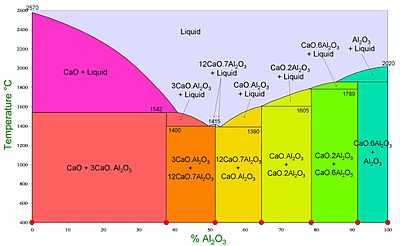Calcium aluminate cements

Calcium aluminate cements[1] are cements consisting predominantly of hydraulic calcium aluminates. Alternative names are "aluminous cement", "high-alumina cement" and "Ciment fondu" in French. They are used in a number of small-scale, specialized applications.
History
The method of making cement from limestone and low-silica bauxite was patented in France in 1908 by Bied of the Pavin de Lafarge Company. The initial development was as a result of the search for a cement offering sulfate resistance. The cement was called in the French "Ciment fondu". Subsequently, its other special properties were discovered, and these guaranteed its future in niche applications.
Composition
The main active constituent of calcium aluminate cements is monocalcium aluminate (CaAl2O4, CaO · Al2O3, or CA in the cement chemist notation). It usually contains other calcium aluminates as well as a number of less reactive phases deriving from impurities in the raw materials. Rather a wide range of compositions is encountered, depending on the application and the purity of aluminium source used.[2] Constituents of some typical formulations include:
| Oxide/Mineral | General purpose | Buff | White | Refractory |
|---|---|---|---|---|
| SiO2 | 4.0 | 5.0 | 2.7 | 0.4 |
| Al2O3 | 39.4 | 53.0 | 62.4 | 79.6 |
| Fe2O3 | 16.4 | 2.0 | 0.4 | 0 |
| CaO | 38.4 | 38.0 | 34.0 | 19.8 |
| MgO | 1.0 | 0.1 | 0.1 | 0 |
| Na2O | 0.1 | 0.1 | 0 | 0 |
| K2O | 0.2 | 0 | 0 | 0 |
| TiO2 | 1.9 | 1.8 | 0.4 | 0.1 |
| Monocalcium aluminate | 46 | 70 | 70 | 35 |
| Dodecacalcium hepta-aluminate | 10 | 5 | 0 | 0 |
| Monocalcium dialuminate | 0 | 0 | 17 | 30 |
| Belite | 7 | 5 | 0 | 0 |
| Gehlenite | 4 | 14 | 11 | 1 |
| Ferrite | 24 | 5 | 2 | 0 |
| Pleocroite | 1 | 1 | 1 | 0 |
| Wüstite | 7 | 0 | 0 | 0 |
| Corundum | 0 | 0 | 0 | 33 |
The mineral phases all take the form of solid solutions with somewhat variable compositions
Manufacture
The cement is made by fusing together a mixture of a calcium-bearing material (normally calcium oxide from limestone) and an aluminium-bearing material (normally bauxite for general purposes, or refined alumina for white and refractory cements). The liquified mixture cools to a basalt-like clinker which is ground alone to produce the finished product. Because complete melting usually takes place, raw materials in lump-form can be used. A typical kiln arrangement comprises a reverberatory furnace provided with a shaft preheater in which the hot exhaust gases pass upward as the lump raw material mix passes downward. The preheater recuperates most of the heat in the combustion gases, dehydrates and de-hydroxylates the bauxite and de-carbonates the limestone. The calcined material drops into the "cool end" of the melt bath. The melt overflows the hot end of the furnace into molds in which it cools and solidifies. The system is fired with pulverized coal or oil. The cooled clinker ingots are crushed and ground in a ball-mill. In the case of high-alumina refractory cements, where the mix only sinters, a rotary kiln can be used.
Reaction with water
The hydration reactions of calcium aluminate cements are very complex. The strength-developing phases are monocalcium aluminate, dodeca-calcium hepta-aluminate and belite. Calcium aluminoferrite, monocalcium dialuminate, gehlenite and pleochroite contribute little to strength.
The reactive aluminates react with water initially to form a mixture of:
CaO · Al2O3 · 10 H2O,
2 CaO · Al2O3 · 8 H2O,
3 CaO · Al2O3 · 6 H2O, and Al(OH) 3 gel,
the amounts of each depending upon the curing temperature.
The first two hydrates subsequently decompose to a mixture of 3 CaO · Al2O3 · 6 H2O, Al(OH)3 gel and water, this process being called "conversion". Because of the loss of water, conversion causes an increase in porosity, which can be accompanied by a decrease in strength. This need not be a problem in structural concrete provided that a sufficiently high cement content and a sufficiently low water/cement ratio are employed.[3]
Applications
Because of their relatively high cost, calcium aluminate cements are used in a number of restricted applications:
- in construction concretes, rapid strength development is achieved, even at low temperatures.
- in construction concretes, high chemical resistance is possible.
- in refractory concretes, strength is maintained at high temperatures.
- as a component in blended cement formulations, various properties such as ultra-rapid strength development and controlled expansion can be obtained.
Problems
Incorrect use of calcium aluminate cements has led to widespread construction problems, especially during the third quarter of the 20th century when this type of cement was used because of its faster hardening properties. After several years some of the buildings and structures collapsed due to degradation of the cement and many had to be torn down or reinforced. Heat and humidity accelerate the degradation process called "conversion"; the roof of a swimming pool was one of the first structures to collapse in the UK.[4]
In Madrid, Spain, a large housing block nicknamed Korea (because it was built to house Americans during the Korean War), built 1951~1954 was affected and had to be torn down in 2006. Also in Madrid the Vicente Calderón soccer stadium was affected and had to be partially rebuilt and reinforced.[5]
References
- ↑ Hewlett P.C. (Ed.) (1998) Lea's Chemistry of Cement and Concrete: 4th Ed, Arnold, ISBN 0-340-56589-6, Chapter 13.
- ↑ Taylor H.F.W. (1990) Cement Chemistry, Academic Press, ISBN 0-12-683900-X, p. 317.
- ↑ Taylor ibid p. 330.
- ↑ http://webs.demasiado.com/forjados/patologia/aluminoso/index.htm Degradación de los hormigones fabricados con cemento aluminoso
- ↑ http://www.elmundo.es/papel/2007/02/07/madrid/2082060.html